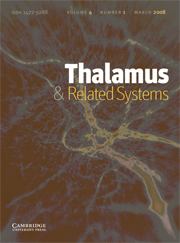Article contents
The dual pattern of corticothalamic projection of the premotor cortex in macaque monkeys
Published online by Cambridge University Press: 18 April 2006
Abstract
The terminals formed by the corticothalamic axons are of two types, small and giant endings. This dual mode of corticothalamic projection has been found to be consistent across species (mouse, rat, cat, monkey) and across systems (visual, auditory, somatosensory and motor). In the monkey, this dual mode of projection has been demonstrated for the motor system in the case of the primary motor cortical area, the supplementary motor area and the caudal part of the dorsal premotor cortex. Based on biotinylated dextran amine anterograde tracing experiments, a similar dual mode of termination morphology was found here for corticothalamic axons originating from the other three distinct sub-divisions of the premotor cortex. Furthermore, the pattern of arrangement of giant endings originating from the premotor cortex was found to be similar to that from the supplementary motor area but different to that from the primary motor cortex.
- Type
- Research Article
- Information
- Copyright
- Elsevier Science Ltd
- 5
- Cited by


